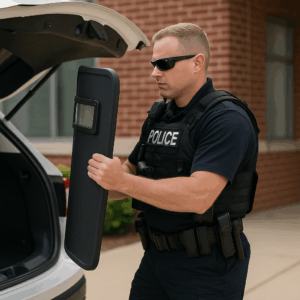Fencing is an essential part of school safety, creating a secure perimeter that helps control access and delay intruders.
The Texas Administrative Code §61.1031 sets specific standards for fencing, ensuring schools have effective barriers to protect students and staff.
These rules cover fencing height, design features, and maintenance to maximize security.
What Are the Requirements?
To comply with Texas school safety standards, fencing must meet these criteria:
- Height and Anti-Scaling Features
- Fences must be at least 6 feet tall if they include anti-scaling features, such as:
- Barbed wire or angled tops.
- Chain link with slats or windscreens.
- Etc.
- If fences do not include anti-scaling features, they must be at least 8 feet tall to compensate for the lack of climbing deterrents.
- Fences must be at least 6 feet tall if they include anti-scaling features, such as:
- Gate Security
- Gates must remain locked when not in use.
- Emergency egress hardware is required to allow quick evacuation.
- Gates should prevent opening from the outside without a key, code, or combination.
- Maintenance and Visibility
- Fencing must be well-maintained, with no gaps or broken sections.
- Landscaping or structures near the fence should not obstruct visibility or create hiding spots.
Why Does Fencing Matter?
Fencing is a critical part of layered security, providing several benefits:
- Deters Intruders: A tall fence with anti-scaling features discourages unauthorized entry.
- Creates Time Barriers: Even if breached, a fence delays intruders, giving staff and first responders more time to react.
- Defines Safe Zones: Enclosed spaces like playgrounds or sports fields allow students to move safely within the campus perimeter.
Fencing also helps funnel visitors to monitored entry points, ensuring they are screened before accessing the building.
How Schools Can Comply
To meet these requirements, schools should:
- Evaluate Current Fencing: Check for compliance with height and anti-scaling standards.
- Upgrade Weak Points: Add height or anti-scaling features where needed.
- Inspect and Maintain: Regularly check fencing for damage and ensure clear sightlines around the perimeter.
- Secure Gates: Make sure all gates lock securely and meet emergency egress requirements.
A Critical Part of Campus Safety
Fencing isn’t just about marking boundaries—it’s a key part of a school’s overall safety strategy. By meeting Texas standards, schools can protect their campuses, delay intruders, and create a secure environment for students and staff.
Need help upgrading your fencing system? Contact us for a consultation.






